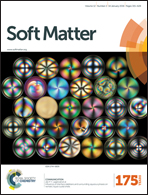Dewetting transition induced by surfactants in sessile droplets at the early evaporation stage
Abstract
As surfactants are employed to control the wettability of solutions, we observe that the sessile droplet dewetting induced by autophobing exhibits a unique relation with the surfactant concentration. Below the critical micelle concentration (cmc) of the surfactant, the autophobic effect makes the droplet go through a rapid depinning at first (Phase 1) and then a relatively slower shrinkage (Phase 2). Unexpectedly, the rapid velocity of the three-phase contact line in Phase 1 shows a transition as the surfactant concentration increases above 0.043 cmc, while such a transition is absent for the velocity in Phase 2. The spreading of the sessile droplets as they form before retraction, the maximum contact angle led by dewetting, and the droplet lifetime are regularly sensitive to the surfactant concentration as well. These phenomena are correlated with the assembling structure and the adsorbed amount at different interfaces with the loading of surfactant inventory.


 Please wait while we load your content...
Please wait while we load your content...